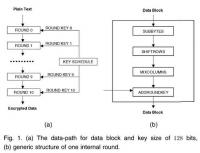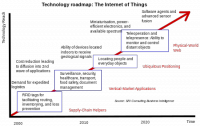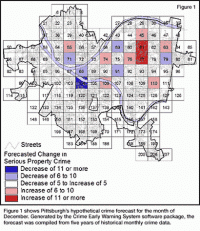-
Encryption prevents FBI from cracking San Bernardino attackers’ phone

U.S. law enforcement agencies have been unable to access a telephone used by the two Islamist attackers in the San Bernardino shooting, FBI director James Comey said Tuesday. Comey stressed that the post-Snowden end-to-end encryption some technology companies are now offering their customers make it impossible for law enforcement to learn more about terrorists and criminal networks, even after terrorist or criminal acts have been committed and even if a court has approved access to the information.
-
-
Intelligence agencies could use Internet-of-things to spy on people

James Clapper, the director of U.S. national intelligence, told lawmakers the other day that the Internet of things — baby monitors, TV set, home security devices, voice recognition dolls – may be used by intelligence services to spy on people. Clapper, testifying yesterday before a Senate panel, said that intelligence agencies might be able to use this new generation of household devices to increase their surveillance capabilities.
-
-
Doubts cast on Continuity IRA's claims of responsibility for Friday’s gang member shooting

Irish security sources have expressed their doubts over a claim by the Continuity IRA that it had carried out the attack on a boxing weigh-in at a Dublin hotel on Friday. Gang member David Byrne was shot dead and two others were injured in the carefully planned attack at the Regency hotel. The attack was carried out by six gunmen, one dressed as a woman.
-
-
Gun deaths in U.S. highest among high-income nations

New study finds that the United States, despite having only half the population of the other twenty-two high-income nations combined, accounted for 82 percent of all firearm deaths. In addition, the United State accounted for 90 percent of all women, 91 percent of children aged 0 to 14 years, and 92 percent of youth aged 15 to 24 years who are killed by firearms.
-
-
Iran nuclear deal: how to ensure compliance?
The U.S. and European countries lifted nuclear-related sanctions against Iran on 16 January as part of a deal in which the country agreed to limit its nuclear activities and accept a new system of international inspections. The issue now is how the international community can be confident that Iran is not violating the deal. Iran agreed never to develop nuclear weapons when it signed the Nuclear Non-Proliferation Treaty in 1968. There’s no ironclad method to prevent Iran from breaking its promise and developing nuclear weapons, but this new agreement builds in a number of strong protections. In conjunction with U.S. and allied intelligence capabilities, these rules mean even a sophisticated and carefully executed secret plan would carry a high risk of detection.Looking at the deal as a whole, Iran’s best strategy for acquiring nuclear weapons would simply be to wait for restrictions on its declared enrichment program to be lifted. Assuming that the deal does not fall apart sooner, most of those provisions are scheduled to expire in 2030. In the meantime, the deal helps make a nuclear-armed Iran a less immediate prospect.
-
-
U.S. must address the “wicked problem” of wildfire

U.S. wildfires burned more than 10.1 million acres in 2015 — a new record. Wildfire suppression costs the United States, on average, $2.9 billion a year. Researchers say that the United States must make preparing for and adapting to wildfire a top national priority, recognizing that widfire is a “wicked problem” — one so complex that a one-size-fits-all solution does not exist.
-
-
Brennan Center sues DHS, DOJ to make “Countering Violent Extremism” records public

The Brennan Center for Justice at NYU School of Law last week sued DHS and the Department of Justice under the Freedom of Information Act (FOIA) for records pertaining to an inter-agency initiative known as “Countering Violent Extremism” (CVE). The CVE initiative is designed to identify and preempt Americans from becoming involved in “violent extremism” and is being implemented in Muslim communities in several parts of the country, including the three formally designated pilot cities of Los Angeles, Boston, and Minneapolis-St. Paul.
-
-
IT system allows police to predict crimes, better organize police shifts

Scientists have developed an IT system based in mathematical algorithms which allows to predict how many and what type of crimes are going to be committed in the next police shift. The developer say that it is about using scientific methods for police patrolling, and that it is the first case of predictive police methods are combined with a mathematical patrolling model.
-
-
Software helps detect nuclear tests
When North Korea conducted its recent nuclear weapon test, it was not terribly difficult to detect. It was a fairly large blast, it occurred in a place where a test was not surprising, and the North Korean government made no effort to hide it. But clandestine tests of smaller devices, perhaps by terrorist organizations or other nonstate actors, are a different story. It is those difficult-to-detect events that the Vertically Integrated Seismic Analysis (VISA) — a machine learning system — aims to find.
-
-
Anaheim police employed Stingray surveillance devices

Police in Anaheim, California have been using Stingray surveillance devices, as well as employing the more intrusive cousin, “dirtboxes,” during active investigations, without the knowledge of residents. More than 400 new documents obtained by the American Civil Liberties Union show that the department has requested funds for the technology, and that it has been using the devices since at least 2009.
-
-
Oregon militia member killed, others arrested after standoff with police
Arizona rancher Robert “LaVoy” Finicum, 55, one of the armed antigovernment protesters occupying a remote federal facility in eastern Oregon, has been killed in a shootout with the FBI and state police. The group’s leader, Nevada rancher Ammon Bundy, and five other men were arrested. Those arrested were charged with conspiracy to impede officers of the United States from discharging their official duties through the use of force, intimidation, or threats.
-
-
It is 3 minutes to midnight -- still

The Bulletin of the Atomic Scientists yesterday announced that the minute hand of the Bulletin’s closely watched Doomsday Clock will remain at three minutes to midnight, since recent progress in the Iran nuclear agreement and the Paris climate accord “constitute only small bright spots in a darker world situation full of potential for catastrophe.” The Bulletin’s panel of security experts said that “Three minutes (to midnight) is too close. Far too close…” – but that this reflects “world leaders continue to fail to focus their efforts and the world’s attention on reducing the extreme danger posed by nuclear weapons and climate change. When we call these dangers existential, that is exactly what we mean: They threaten the very existence of civilization and therefore should be the first order of business for leaders who care about their constituents and their countries.”
-
-
Paramedics' risk of being assaulted far exceeds risk to firefighting colleagues
Research found that y medical technicians and paramedics are fourteen times more likely to be violently injured on the job than the firefighters they work alongside. The researchers found that assault-related injuries are often not reported, not acknowledged by administration, and therefore they are internalized by the workers as a “part of the job.”
-
-
Paramedics' risk of being assaulted far exceeds risk to firefighting colleagues

Research found that y medical technicians and paramedics are fourteen times more likely to be violently injured on the job than the firefighters they work alongside. The researchers found that assault-related injuries are often not reported, not acknowledged by administration, and therefore they are internalized by the workers as a “part of the job.”
-
-
Europol bolsters EU’s counterterrorism capabilities
Europe is currently facing the most significant terrorist threat in over ten years. The Paris attacks on 13 November 2015 indicate a shift toward a clear international dimension of Islamic State to carry out special forces-style attacks in the international environment. This and the growing number of foreign fighters are posing new challenges for EU Member States. Europol says that more attacks in the EU may happen in the future. Therefore, there is a great need within the European Union to strengthen our response to terror, to suspected terrorist networks and foreign fighters, and have an improved strategic understanding of threats.
-
More headlines
The long view
Factories First: Winning the Drone War Before It Starts
Wars are won by factories before they are won on the battlefield,Martin C. Feldmann writes, noting that the United States lacks the manufacturing depth for the coming drone age. Rectifying this situation “will take far more than procurement tweaks,” Feldmann writes. “It demands a national-level, wartime-scale industrial mobilization.”
How Male Grievance Fuels Radicalization and Extremist Violence
Social extremism is evolving in reach and form. While traditional racial supremacy ideologies remain, contemporary movements are now often fueled by something more personal and emotionally resonant: male grievance.
The Surprising Reasons Floods and Other Disasters Are Deadlier at Night
It’s not just that it’s dark and people are asleep. Urban sprawl, confirmation bias, and other factors can play a role.
Why Flash Flood Warnings Will Continue to Go Unheeded
Experts say local education and community support are key to conveying risk.
